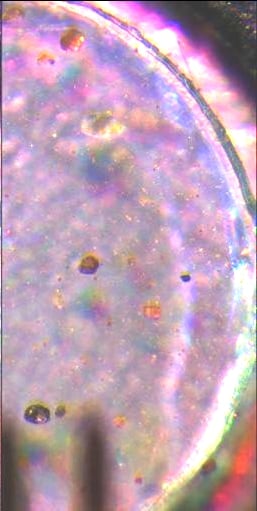"To see a world in a grain of sand…" â€" English Poet William Blake
The Phoenix science team tested out the lander's Optical Microscope by imaging grains of sand and dust particles, some as small as one-tenth the diameter of a human hair. These are the highest resolution image ever of small soil particles from another planet. "We have images showing the diversity of mineralogy on Mars at a scale that is unprecedented in planetary exploration," said Michael Hecht of NASA's Jet Propulsion Laboratory.
The microscope observed particles that had fallen onto an exposed surface of the lander. "It's a first quick look," Hecht said. "This experiment was partly an insurance policy for something to observe with the microscope before getting a soil sample delivered by the arm, and partly a characterization of the Optical Microscope. All the tools are working well."
However, some of the particles may be "alien" â€" that is, they might have come from inside the spacecraft when Phoenix dropped to Mars surface at landing. But at first glance, many of these grains match expectations for Martian particles. "We will be using future observations of soil samples delivered by the Robotic Arm to confirm whether the types of particles in this dustfall sample are also seen in samples we can be certain are Martian in origin," Hecht said.
The particles show a range of shapes and colors.
"You can see the amount of variety there is in what appears otherwise to be just reddish brown soil," said Tom Pike, Phoenix science team member from Imperial College London. He noted that one translucent particle resembles a grain of salt, but that it is too early to say for sure.
Meanwhile, Phoenix received commands Thursday to collect its first soil sample to be delivered to its science lab instrument on the lander deck. Those commands were originally sent on Wednesday, but the lander didn't receive them as the relay for the commands, the Mars Odyssey, had gone into safe mode. The orbiter
may have been hit by a cosmic ray,
and engineers from JPL say nominal operations of the spacecraft should return by the end of the week. This type of event has occurred a couple of times in the Odyssey mission, and engineers don't appear overly concerned about the situation.
So, the commands were successfully re-sent via the Mars Reconnaissance Orbiter. Look for the first science results from Phoenix within the next day or so.
Original News Source:
Phoenix news release
 Universe Today
Universe Today
